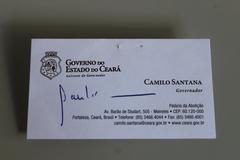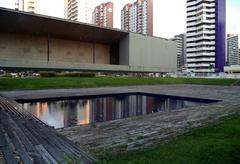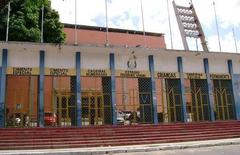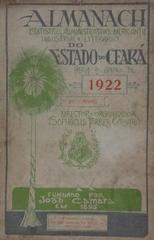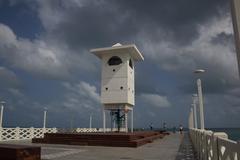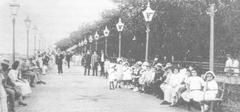
Santa Casa de Misericórdia de Fortaleza: Visiting Hours, Tickets, and Historical Significance
Date: 04/07/2025
Introduction
Santa Casa de Misericórdia de Fortaleza, located in the vibrant Centro district, is not only a pioneering hospital but also a cultural and historical landmark in Fortaleza, Ceará, Brazil. Since its founding in 1861, amidst epidemics and droughts, Santa Casa has played a vital role in the city’s social, medical, and architectural evolution. Today, it remains a living testament to over 160 years of community service, innovation, and philanthropy, bridging the past and present through its active medical services, architectural grandeur, and public engagement (ipatrimonio.org; pt.wikipedia.org).
This guide provides visitors with a detailed overview of Santa Casa de Misericórdia de Fortaleza’s history, cultural significance, visiting hours, ticket information, accessibility, and practical travel tips for an enriching experience.
Table of Contents
- Introduction
- Historical Foundations and Early Development
- The Irmandade da Misericórdia and Social Mission
- Expansion, Innovation, and Institutional Milestones
- Architectural and Cultural Heritage
- Modern Services and Facilities
- Visiting Santa Casa: Hours, Tickets, Tours, and Accessibility
- Nearby Attractions and Travel Tips
- Legacy, Preservation, and Community Relevance
- Frequently Asked Questions (FAQ)
- Summary and Call to Action
- References and Official Links
Historical Foundations and Early Development
The establishment of Santa Casa de Misericórdia de Fortaleza was a response to the dire public health crises that plagued Fortaleza in the 19th century. The devastating drought of 1845 and recurring epidemics underscored the need for a charitable institution dedicated to healthcare and social welfare.
The initiative was led by Dom João da Purificação Marques Perdigão, then Bishop of Recife and Olinda, and received land donations from Dona Maria Guilhermina Gouveia. Construction began in 1847 at what is now Rua Barão do Rio Branco, 20, with funding from the imperial court and local benefactors. The hospital officially opened its doors on September 19, 1861, with 80 beds, becoming Fortaleza’s first hospital (ipatrimonio.org; pt.wikipedia.org).
The Irmandade da Misericórdia and Social Mission
From its inception, Santa Casa was managed by the Irmandade Beneficente da Santa Casa da Misericórdia de Fortaleza, a religious brotherhood rooted in Catholic charity. Their stewardship ensured not just the hospital’s survival but also its firm commitment to serving society’s most vulnerable, setting standards for compassion, solidarity, and public service (ipatrimonio.org).
Expansion, Innovation, and Institutional Milestones
Over the decades, Santa Casa evolved to meet the city’s growing healthcare needs:
- Yellow Fever and Drought Response: The hospital played a critical role during epidemics and the catastrophic drought of 1915 (pt.wikipedia.org).
- Technological Pioneering: In 1925, it introduced Ceará’s first X-ray machine, cementing its reputation for medical innovation.
- Growth of Services: The 20th century saw the addition of a maternity ward (1928), emergency service (1932–1936), and integration with the Federal University of Ceará’s Faculty of Medicine (1957), fostering medical research and education (opovo.com.br).
- Modernization: In 1971, a new surgical center was inaugurated, and by 2009, the hospital offered over 400 beds and robust emergency care (pt.wikipedia.org).
Architectural and Cultural Heritage
Santa Casa’s architecture is a blend of neoclassical and eclectic styles—symmetrical façades, arched windows, and grand porticos—reflecting European influences of the late 19th century (applocal.com.br). The hospital’s design prioritized ventilation and natural light, crucial for hygiene and patient well-being in the tropical climate.
The hospital’s central location has made it a hub for community events and cultural activities, further establishing it as a symbol of Fortaleza’s urban identity and collective memory. Its designation as a protected heritage site by the Municipality of Fortaleza (Decree No. 13.041/2012) underscores its cultural significance (ipatrimonio.org).
Modern Services and Facilities
Santa Casa is recognized for its comprehensive healthcare provision, serving both private and public (SUS) patients. Modern facilities include:
- Advanced Diagnostics: Ultrasonography, tomography, X-ray, endoscopy, mammography, and more (Santa Casa Saúde).
- Specialized Units: Oncology center (upgrading to CACON), hemodialysis clinic, and Hospital Psiquiátrico São Vicente de Paulo for mental health care.
- Emergency and Intensive Care: 24/7 emergency services, surgical center, and ICU (Santa Casa).
- Humanized Care: Strong focus on ethical, equitable, and humanized treatment, with more than 95% of patients served through SUS.
- Cemitério São João Batista: Managed by Santa Casa, this cemetery is a historical and cultural landmark in its own right, often included in guided tours (Santa Casa).
Visiting Santa Casa: Hours, Tickets, Tours, and Accessibility
Visiting Hours:
- Monday to Friday, 8:00 AM to 6:00 PM for the hospital
- Cemitério São João Batista: 8:00 AM to 5:00 PM
- Some areas may have restricted access due to patient care.
Tickets and Entry:
- No entrance fee for public areas or the cemetery.
- Guided tours of the historic areas and cemetery can be arranged by appointment, sometimes for a nominal fee (santacasace.org.br).
Accessibility:
- The facility is equipped with ramps, elevators, and accessible restrooms. Some heritage areas may have limited accessibility due to the building’s age.
Photography:
- Permitted in public and outdoor areas; restricted in medical zones to protect privacy.
Travel and Practical Tips:
- Wear comfortable shoes for cobbled streets.
- The site is centrally located, making it convenient for combining visits with other Fortaleza historical sites such as the Metropolitan Cathedral and Dragão do Mar Center of Art and Culture.
- For current events, guided tours, or accessibility needs, contact administration via the official website.
Nearby Attractions and Travel Tips
While at Santa Casa, consider visiting:
- Passeio Público: Historical square adjacent to the hospital.
- Dragão do Mar Center of Art and Culture: Cultural complex with museums and theaters.
- Fortaleza Cathedral and Central Market: Excellent for learning about local culture and architecture.
Legacy, Preservation, and Community Relevance
Santa Casa de Misericórdia de Fortaleza endures as a beacon of charity, innovation, and community engagement. Restoration projects ensure the preservation of its architectural and historical legacy while supporting modern healthcare delivery (dspace.mackenzie.br). The hospital’s ongoing challenges—primarily funding shortfalls from the public health system—have prompted new strategies for sustainability, including partnerships and planned expansions such as the upgraded oncology center and enhanced cultural programming at the cemetery (Santa Casa).
Frequently Asked Questions (FAQ)
Q: What are the visiting hours for Santa Casa and the cemetery?
A: Hospital: Monday to Friday, 8:00 AM to 6:00 PM; Cemetery: 8:00 AM to 5:00 PM.
Q: Is there an entrance fee?
A: No, entry is free. Certain guided tours may have a nominal fee.
Q: Are guided tours available?
A: Yes, by appointment.
Q: Is the facility accessible for visitors with disabilities?
A: Most areas are accessible; contact administration for specific needs.
Q: Can I take photographs inside Santa Casa?
A: Only in permitted areas; check with staff for restrictions.
Summary and Call to Action
Santa Casa de Misericórdia de Fortaleza is a vital intersection of history, architecture, and healthcare. Its evolution from a small charitable hospital to a leading modern institution mirrors the city’s own growth and resilience. For travelers, history enthusiasts, and locals alike, Santa Casa offers an enriching journey through Brazil’s medical, social, and cultural heritage.
Plan your visit by checking official visiting hours and tour availability. For updates, event announcements, and guided tours, follow Santa Casa’s official channels and consider downloading the Audiala app for immersive audio guides to Fortaleza’s cultural sites.

